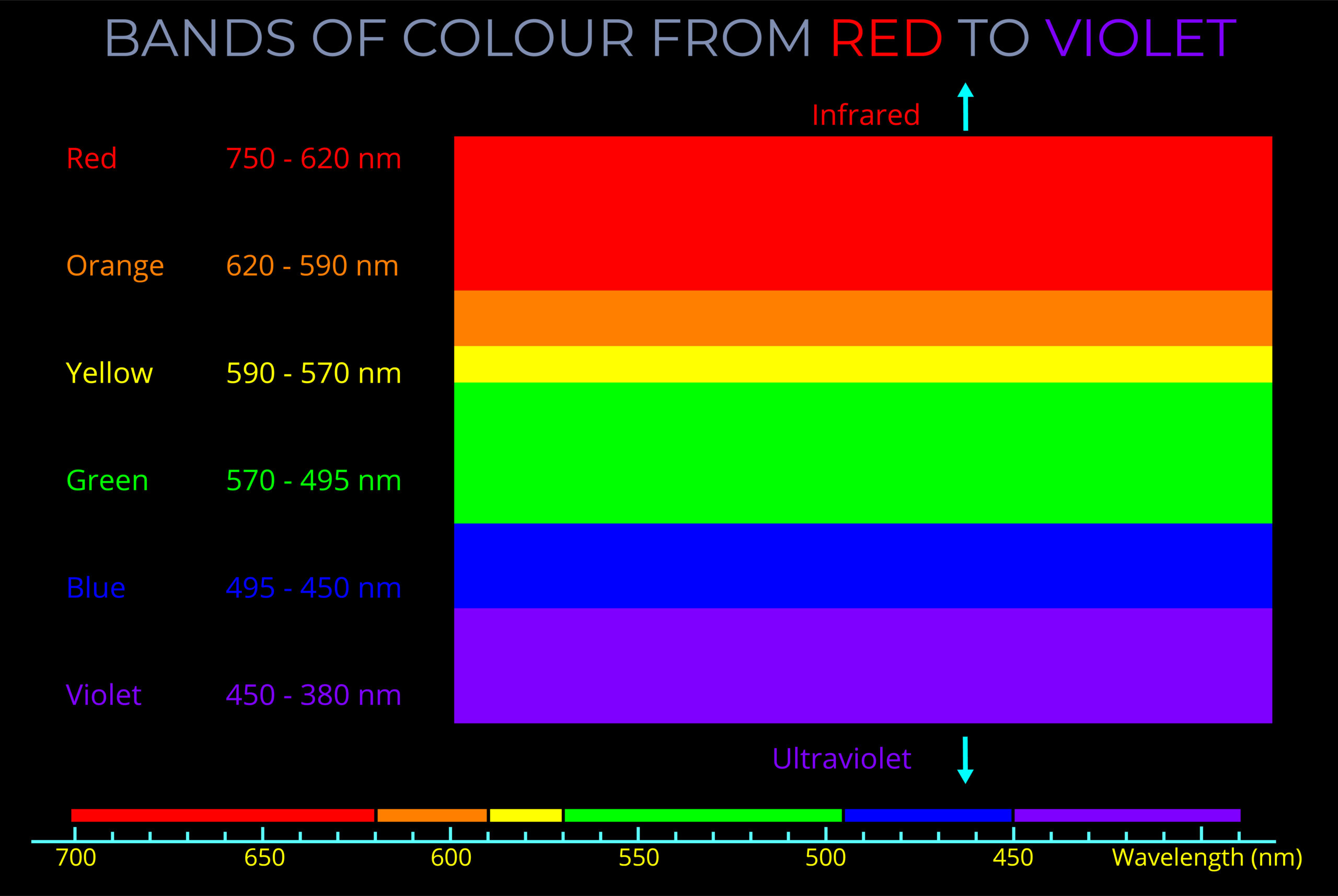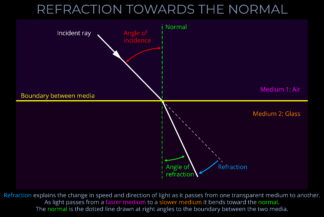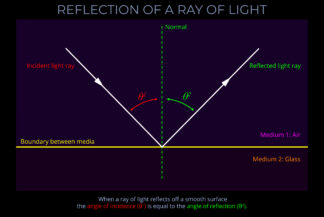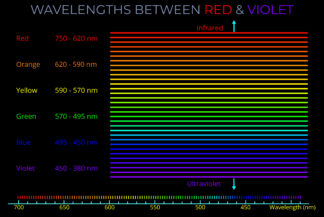Bands of Colour from Red to Violet
£0.00
This diagram is about the fact that wavelengths of light within the visible spectrum often appear to form bands of colour.
- Every wavelength of electromagnetic radiation (light) corresponds with a different colour we see in the world.
- When an observer sees a continuous range of wavelengths they see bands of colour.
- When all wavelengths within the visible spectrum are present an observer will often see six bands of colour – the colours of the rainbow, ROYGBV.
- The list on the left of the diagram shows the range of wavelengths corresponding with each band of colour.
Remember that:
- Objects appear to be different colours depending on the wavelengths that are reflected towards an observer.
- The name given to light that contains all wavelengths of the visible spectrum is white light.
- When all wavelengths contained in white light reflect off a neutral coloured surface then the object appears white to an observer.
- When one or several bands of wavelengths reflect off a neutral coloured surface then the object appears coloured to an observer.
- The colour an observer sees depends on the wavelengths of visible light emitted by a light source and on which of those wavelengths are reflected off an object.
- Although a human observer can distinguish between many thousands of wavelengths of light in the visible spectrum our brains often produce the impression of bands of colour.
Description
Bands of Colour from Red to Violet
TRY SOME QUICK QUESTIONS AND ANSWERS TO GET STARTED
About the diagram
About the diagram
- This diagram is about the fact that wavelengths of light within the visible spectrum often appear to form bands of colour.
- Every wavelength of electromagnetic radiation (light) corresponds with a different colour we see in the world.
- When an observer sees a continuous range of wavelengths they see bands of colour.
- When all wavelengths within the visible spectrum are present an observer will often see six bands of colour – the colours of the rainbow, ROYGBV.
- The list on the left of the diagram shows the range of wavelengths corresponding with each band of colour.
Remember that:
- Objects appear to be different colours depending on the wavelengths that are reflected towards an observer.
- The name given to light that contains all wavelengths of the visible spectrum is white light.
- When all wavelengths contained in white light reflect off a neutral coloured surface then the object appears white to an observer.
- When one or several bands of wavelengths reflect off a neutral coloured surface then the object appears coloured to an observer.
- The colour an observer sees depends on the wavelengths of visible light emitted by a light source and on which of those wavelengths are reflected off an object.
- Although a human observer can distinguish between many thousands of wavelengths of light in the visible spectrum our brains often produce the impression of bands of colour.
Let’s look at this in more detail:
- An observer perceives bands of colour because:
- The human eye is able to distinguish between some wavelengths of visible light better than others. Another factor is that some colours appear to be brighter than others to a human observer.
- Colour is not a property of electromagnetic radiation, but a feature of visual perception.
- It is the human brain that draws lines between different bands of colour when an observer looks at a rainbow for example.
- A human observer can distinguish between colours corresponding with many thousands of single wavelengths of light in the visible spectrum. These colours are called spectral colours.
- Combinations of wavelengths from different areas of the visible spectrum produce other colours when perceived by a human observer which are called non-spectral colours.
- There is no property belonging to electromagnetic radiation that causes bands of colour to appear to an observer. The fact that we do see distinct bands is often described as an artefact of human colour vision.
- The visible spectrum is formed of a smooth and continuous range of wavelengths that can be demonstrated to produce a smooth and continuous range of colours.
- Cone cells in our eyes are particularly sensitive to red, green and blue wavelengths.
- Our brains process information received from the eye to produce all the colours of the visible spectrum.
Some key terms
Visible light is the range of wavelengths of electromagnetic radiation perceived as colour by human observers.
- Visible light is a form of electromagnetic radiation.
- Other forms of electromagnetic radiation include radio waves, microwaves, infrared, ultraviolet, X-rays, and gamma rays.
- Visible light is perceived by a human observer as all the spectral colours between red and violet plus all other colours that result from combining wavelengths together in different proportions.
- A spectral colour is produced by a single wavelength of light.
- The complete range of colours that can be perceived by a human observer is called the visible spectrum.
- The range of wavelengths that produce visible light is a very small part of the electromagnetic spectrum.
Visible light refers to the range of wavelengths of electromagnetic radiation that is perceived as colour by human observers. While the range of visible light is generally considered to be 400-700 nm, the exact range of colours perceptible can vary slightly between individuals.
- Visible light is one form of electromagnetic radiation. Other forms of electromagnetic radiation include radio waves, microwaves, infrared, ultraviolet, X-rays, and gamma rays. Visible light ranges from approximately 400 nanometres (nm) for violet to 700 nm for red.
- A human observer perceives visible light as a combination of all the spectral colours between red and violet, as well as a vast range of other colours produced from the blending of different wavelengths in varying proportions.
The visible part of the electromagnetic spectrum is called the visible spectrum.
- The visible spectrum is the range of wavelengths of the electromagnetic spectrum that correspond with all the different colours we see in the world.
- As light travels through the air it is invisible to our eyes.
- Human beings don’t see wavelengths of light, but they do see the spectral colours that correspond with each wavelength and colours produced when different wavelengths are combined.
- The visible spectrum includes all the spectral colours between red and violet and each is produced by a single wavelength.
- The visible spectrum is often divided into named colours, though any division of this kind is somewhat arbitrary.
- Traditional colours referred to in English include red, orange, yellow, green, blue, and violet.
The electromagnetic spectrum includes electromagnetic waves with all possible wavelengths of electromagnetic radiation, ranging from low-energy radio waves through visible light to high-energy gamma rays.
- There are no precisely defined boundaries between the bands of electromagnetic radiation in the electromagnetic spectrum.
- The electromagnetic spectrum includes, in order of increasing frequency and decreasing wavelength: radio waves, microwaves, infrared radiation, visible light, ultraviolet radiation, X-rays and gamma rays.
- Visible light is only a very small part of the electromagnetic spectrum.
The visible spectrum is the range of wavelengths of the electromagnetic spectrum that correspond with all the different colours we see in the world.
- As light travels through the air it is invisible to our eyes.
- Human beings don’t see wavelengths of light, but they do see the spectral colours that correspond with each wavelength and colours produced when different wavelengths are combined.
- The visible spectrum includes all the spectral colours between red and violet and each is produced by a single wavelength.
- The visible spectrum is often divided into named colours, though any division of this kind is somewhat arbitrary.
- Traditional colours referred to in English include red, orange, yellow, green, blue, and violet.
The spectral colour model represents the range of pure colours that correspond to specific wavelengths of visible light. These colours are called spectral colours because they are not created by mixing other colours but are produced by a single wavelength of light. This model is important because it directly reflects how human vision perceives light that comes from natural sources, like sunlight, which contains a range of wavelengths.
- The spectral colour model is typically represented as a continuous strip, with red at one end (longest wavelength) and violet at the other (shortest wavelength).
- Wavelengths and Colour Perception: In the spectral colour model, each wavelength corresponds to a distinct colour, ranging from red (with the longest wavelength, around 700 nanometres) to violet (with the shortest wavelength, around 400 nanometres). The human eye perceives these colours as pure because they are not the result of mixing other wavelengths.
- Pure Colours: Spectral colours are considered “pure” because they are made up of only one wavelength. This is in contrast to colours produced by mixing light (like in the RGB colour model) or pigments (in the CMY model), where a combination of wavelengths leads to different colours.
- Applications: The spectral colour model is useful in understanding natural light phenomena like rainbows, where each visible colour represents a different part of the light spectrum. It is also applied in fields like optics to describe how the eye responds to light in a precise, measurable way.
An observer perceives bands of colour when visible light separates into its component wavelengths and the human eye distinguishes a series of distinct adjacent colours.
- The human eye and brain together translate light into colour.
- When rain disperses sunlight and forms a rainbow, an observer will typically distinguish red, orange, yellow, green, blue and violet bands of colour.
- Although a rainbow contains electromagnetic waves with all possible wavelengths between red and violet, some ranges of wavelengths appear more intense to a human observer than others.
Wavelength measures a complete wave cycle, which is the distance from any point on a wave to the corresponding point on the next wave.
- While wavelength can be measured from any point on a wave, it is often simplest to measure from the peak of one wave to the peak of the next or from the bottom of one trough to the bottom of the next, ensuring the measurement covers the whole of the cycle.
- The wavelength of an electromagnetic wave is usually given in metres.
- The wavelength of visible light is typically measured in nanometres, with 1,000,000,000 nanometres making up a metre.
- Radio waves, visible light, and gamma waves for example, each have different ranges of wavelengths within the electromagnetic spectrum.



